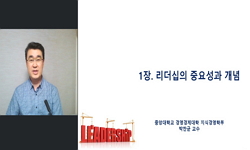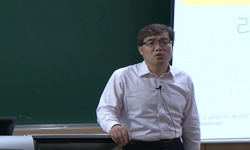The objective of this study is to explore and introspect life paths, individual characteristics, and leadership characteristics of the successful vocational training institution principals. To do so, in-depth interviews were conducted with 8 principal...
http://chineseinput.net/에서 pinyin(병음)방식으로 중국어를 변환할 수 있습니다.
변환된 중국어를 복사하여 사용하시면 됩니다.
- 中文 을 입력하시려면 zhongwen을 입력하시고 space를누르시면됩니다.
- 北京 을 입력하시려면 beijing을 입력하시고 space를 누르시면 됩니다.
최우수 직업훈련 기관장의 리더십 특성에 관한 질적 연구 = A Qualitative Study on the Leadership of Successful Vocational Training Institution Principal
한글로보기https://www.riss.kr/link?id=T14139026
- 저자
-
발행사항
천안 : 한국기술교육대학교 테크노인력개발전문대학원, 2014
-
학위논문사항
학위논문(석사) -- 한국기술교육대학교 테크노인력개발전문대학원 , 인력개발학과 인력개발학전공 , 2014. 2
-
발행연도
2014
-
작성언어
한국어
- 주제어
-
발행국(도시)
충청남도
-
형태사항
; 26 cm
-
일반주기명
지도교수: 임세영
- 소장기관
-
0
상세조회 -
0
다운로드
부가정보
다국어 초록 (Multilingual Abstract)
As a result of open coding, 42 concepts, 32 subcategories, and 9 categories were derived. Through the integrated analysis process of axial coding and exploration of relationships among individuals, organizations, and society.
The results according to the 9 categories are as following:
First, the successful principals were heavily influenced by family members who were either doing business or engaged in educational sector. Moreover, they gladly volunteered to help others and most of them had successful experience in the educational field. These were the factors that motivated them to work in the ‘vocational training field’.
Second, the principals participated in vocational training from the initial stages or were at least involved in the trainings for a long-term.
When new training systems were implemented, many of them were the initiators of these. They were the ‘vocational training pioneers’ of Korea.
Third, the principals settled down as the genuine ‘vocational trainers’, operating institutions with passion and sincerity. Throughout this process, they were able to enjoy and continuously learn about different values.
Fourth, the principals overcame difficult moments of the past with other members and thus felt proud for the fact that they succeeded as ‘vocational training leaders’.
Fifth, the principals were not only energetic, passionate, sincere, and diligent but also positive and modest. In addition to these, they were the people with ‘internal’ characteristics, who had strong patience and ability to introspect.
Sixth, in the relationship with the others, the principals loved conversations and always were ready to hear others’ opinion. Also, they were easygoing and thoughtful of others and did not have any consciousness of authority. The fact they were able to not only understand others but also encourage and sympathize with them was another big characteristic.
Seventh, analyzing principals’ ‘individual leadership characteristics’, it was found out that they had strong confidence in what they were doing and that they had remarkable self-analysis ability. Another characteristic that could be found was the fact that they were continuously studying to prepare for the future and were always taking the initiative to set an example for the others.
Eighth, the 'characteristics of leadership in the organizational level' are summed up as the following. The principals were considering the members as one family and were giving them suggestions on different visions. In order to operate the organization, the principals were
constantly motivating the others and sometimes even allowed the others to take authority over them. Furthermore, they were always conforming to the principles, considering communication to be important, and solving different problems rationally.
Ninth, the principals were carrying out 'public leadership in the social relationship'. In other words, they were contributing to the community by understanding the social responsibility of training institutions and carrying out different social roles. Also, they were embracing the
vocational training as their vocation and not as a mean to gain profit.
The followings are the explanations based on the 'individual-organzational-social relationship based leadership model', which is deduced through analyzing the 'characteristics of successful Vocational Training Institution principals' leadership'.
First, in the organization-individual relationship, the principal was considering the members as ‘one family’ and at the same time as ‘new family’. Indeed, based on a new form of familism, the principal shared infinite affection with both the trainees and the staffs. This means that the principal, staffs, and trainees were in ‘one another family’ and their relationship was mutually beneficial. In the relationship with the members, the successful principal was a ‘new familist’, leading each other and sometime having each others’ back.
Second, in the individual-society relationship, the principal was operating the institution not to gain profit but for the purpose of serving the society, based on the humanism. This humanism started off with sharing love and providing service towards the trainees and staffs and further expanded into serving the local area and even the whole country. In the social relationship, the principal was a ‘humanist’ who considers people as his first priority and provides service.
Third, in the organization-society relationship, the principal wanted something more than just simply train technicians or professionals through the training institution. Indeed, the principal wanted to implement true education. This is possible because the principal considers his job as a duty appointed by the god that he ought to carry out. They were ‘true educators’, who want to implement true education based on vocation.
Eventually, the principals encompass these characteristics in integrated and organic way to be qualified as one of the ‘successful vocational training institution principal’ and to exercise the role of ‘true vocational training leaders’.
This study explores dynamics of the field of vocational training and various relationships and contexts arising within them, on which to put into perspectives the characteritics of leadership displayed by successful vocational training institution principals.
The result of this study not only plays the role of a compass that helps the principals of vocational institutions to decide direction for human focused
The objective of this study is to explore and introspect life paths, individual characteristics, and leadership characteristics of the successful vocational training institution principals. To do so, in-depth interviews were conducted with 8 principals, who fitted into what was defined as the successful institution principals by this study. Interview contents were analyzed using the grounded theory approach.
As a result of open coding, 42 concepts, 32 subcategories, and 9 categories were derived. Through the integrated analysis process of axial coding and exploration of relationships among individuals, organizations, and society.
The results according to the 9 categories are as following:
First, the successful principals were heavily influenced by family members who were either doing business or engaged in educational sector. Moreover, they gladly volunteered to help others and most of them had successful experience in the educational field. These were the factors that motivated them to work in the ‘vocational training field’.
Second, the principals participated in vocational training from the initial stages or were at least involved in the trainings for a long-term.
When new training systems were implemented, many of them were the initiators of these. They were the ‘vocational training pioneers’ of Korea.
Third, the principals settled down as the genuine ‘vocational trainers’, operating institutions with passion and sincerity. Throughout this process, they were able to enjoy and continuously learn about different values.
Fourth, the principals overcame difficult moments of the past with other members and thus felt proud for the fact that they succeeded as ‘vocational training leaders’.
Fifth, the principals were not only energetic, passionate, sincere, and diligent but also positive and modest. In addition to these, they were the people with ‘internal’ characteristics, who had strong patience and ability to introspect.
Sixth, in the relationship with the others, the principals loved conversations and always were ready to hear others’ opinion. Also, they were easygoing and thoughtful of others and did not have any consciousness of authority. The fact they were able to not only understand others but also encourage and sympathize with them was another big characteristic.
Seventh, analyzing principals’ ‘individual leadership characteristics’, it was found out that they had strong confidence in what they were doing and that they had remarkable self-analysis ability. Another characteristic that could be found was the fact that they were continuously studying to prepare for the future and were always taking the initiative to set an example for the others.
Eighth, the 'characteristics of leadership in the organizational level' are summed up as the following. The principals were considering the members as one family and were giving them suggestions on different visions. In order to operate the organization, the principals were
constantly motivating the others and sometimes even allowed the others to take authority over them. Furthermore, they were always conforming to the principles, considering communication to be important, and solving different problems rationally.
Ninth, the principals were carrying out 'public leadership in the social relationship'. In other words, they were contributing to the community by understanding the social responsibility of training institutions and carrying out different social roles. Also, they were embracing the
vocational training as their vocation and not as a mean to gain profit.
The followings are the explanations based on the 'individual-organzational-social relationship based leadership model', which is deduced through analyzing the 'characteristics of successful Vocational Training Institution principals' leadership'.
First, in the organization-individual relationship, the principal was considering the members as ‘one family’ and at the same time as ‘new family’. Indeed, based on a new form of familism, the principal shared infinite affection with both the trainees and the staffs. This means that the principal, staffs, and trainees were in ‘one another family’ and their relationship was mutually beneficial. In the relationship with the members, the successful principal was a ‘new familist’, leading each other and sometime having each others’ back.
Second, in the individual-society relationship, the principal was operating the institution not to gain profit but for the purpose of serving the society, based on the humanism. This humanism started off with sharing love and providing service towards the trainees and staffs and further expanded into serving the local area and even the whole country. In the social relationship, the principal was a ‘humanist’ who considers people as his first priority and provides service.
Third, in the organization-society relationship, the principal wanted something more than just simply train technicians or professionals through the training institution. Indeed, the principal wanted to implement true education. This is possible because the principal considers his job as a duty appointed by the god that he ought to carry out. They were ‘true educators’, who want to implement true education based on vocation.
Eventually, the principals encompass these characteristics in integrated and organic way to be qualified as one of the ‘successful vocational training institution principal’ and to exercise the role of ‘true vocational training leaders’.
This study explores dynamics of the field of vocational training and various relationships and contexts arising within them, on which to put into perspectives the characteritics of leadership displayed by successful vocational training institution principals.
The result of this study not only plays the role of a compass that helps the principals of vocational institutions to decide direction for human focused
국문 초록 (Abstract)
개방코딩 결과 42개의 개념, 32개의 하위범주, 9개의 범주가 도출되었고 축코딩과 연관관계 모형 분석의 통합적 분석의 과정을 통해 범주 간의 관계를 보다 입체적으로 분석하였다.
9개의 범주를 토대로 연구 결과를 정리하면 다음과 같다.
첫째, 최우수 기관장들은 사업을 하거나 교육에 종사하고 있는 가족이나 친척의 영향을 강하게 받았다. 또한 사람을 돕는 것을 선호하였고 교육 혹은 강의에서의 성공경험을 갖고 있었다. 이와 같은 사실들이 ‘직업훈련을 선택하게 된 동기’가 되었다.
둘째, 기관장들은 직업훈련에 장기적으로 참여하거나 초창기부터 참여 하였다. 신규 훈련 제도 도입 시 최초 운영을 하는 경우도 많았다. 그들은 한국의 ‘직업훈련 개척자’였다.
셋째, 기관장들은 열정과 진정성을 지니고 기관을 운영하면서 진정한 의미의 ‘직업훈련인으로 정착’했다. 그리고 그 과정에서 지속적으로 직업훈련에 재미를 느끼고 보람과 가치를 깨달았다.
넷째, 기관장들은 직업훈련의 역사 속에서 맞은 위기를 구성원들과 함께 극복했고 결국 ‘직업훈련 리더로 성공’하였다는 자부심을 느꼈다.
다섯째, 기관장들은 열정과 에너지가 많았고 근면하고 성실하였다. 또한 긍정적이고 겸손한 사람들이었다. 이와 함께 인내심이 강하고 자기성찰을 하는 ‘자기 내인 특성’을 가지고 있었다.
여섯째, 기관장들은 ‘타자와의 관계’에 있어 대화를 좋아하고 경청하는 자세를 지녔다. 또한 소탈하고 권위의식이 없었으며 타인에 대한 배려가 강했 다. 타인을 깊이 이해하고 공감해주며 격려와 지지하는 성향을 가진 점도 커다란 특성이었다.
일곱째, 기관장들의 ‘개인적 리더십 특성’은 업무에 대한 자신감이 있고 자기 분석력이 뛰어난 것으로 정리되었다. 또한 미래에 대비하기 위하여 지속적으로 학습을 하고 솔선수범한다는 특성도 지니고 있었다.
여덟째, ‘조직 차원의 리더십 특성’은 다음과 같이 요약되었다. 기관장들은 구성원들을 가족으로 여기고 있었으며 그들에게 비전을 제시하고 있었 다. 조직을 운영하기 위해 끊임없이 동기 부여를 하고 때로는 권한을 위임하기도 했다. 또한 원칙을 준수하고 의사소통을 중시하였으며 합리적으로 문제해결을 하고 있었다.
아홉째, 기관장들은 ‘사회적 관계에서 공공 리더십’을 수행하고 있었다.
즉, 훈련기관의 사회적 책임을 인식하였고 사회적 역할을 수행하는 방식 으로 지역사회에 기여하고 있었다. 또한 생계나 영리의 수단이라기 보다는 천직으로 직업훈련을 받아들이고 있었다.
이와 같은 최우수 직업훈련 기관장의 리더십 특성을 분석 과정을 통하여 도출된 ‘개인-조직-사회적 관계 중심 리더십 모형’을 토대로 설명하면 다음과 같다.
첫째, 개인-조직 관계에서 기관장은 구성원들을 ‘한가족’이면서 ‘새로운 가족’으로 여기고 있었다. 즉, 새로운 형태의 가족주의(new familism)에 근간을 두고 훈련생과 직원을 가리지 않고 무한애정을 주고받았다. 따라서 기관장-직원-훈련생은 ‘또 하나의 가족’이었으며 이들의 관계는 상호호혜적인 것이다. 최우수 기관장은 구성원과의 관계에서 가족과 같이 서로가 서로를 이끌고 때로는 뒷받침하고 있는 ‘신가족주의자(new familist)’였다.
둘째, 개인-사회 관계에서 기관장은 이윤이나 영리를 추구하기 위해서가 아니라 인본주의(humanism)에 근거하여 사회에 봉사하는 의미로 기관을 운영하고 있었다. 이러한 인본주의는 훈련생과 직원에 대한 봉사와 사랑 에서 출발하여 지역사회, 더 나아가 국가에 이바지 할 수 있도록 넓게 확장되었다. 결국 기관장은 사회적 관계에서 사람을 최우선으로 여기며 봉사를 실천하는 ‘인본주의자(humanist)’였다.
셋째, 조직-사회 관계에서 기관장은 훈련기관을 통하여 단순히 기능인 이나 직업인을 양성한다는 차원을 넘어 참된 교육을 실천하고 싶어 했다.
그것은 자신의 일을 하늘이 준 것이고 마땅히 해야 하는 일로 받아들이고 있었기에 가능한 것이다. 그들은 소명의식(vocation)에 근거하여 진정한 교육을 실현하고 싶어 하는 ‘참교육자(true educator)’였다.
결국 이러한 리더십 특성들이 통합적이고 유기적으로 어우러져 ‘최우수 직업훈련 기관장’에 이르게 되었고 ‘진정한 직업훈련 리더’의 역할을 수행할 수 있었던 것이다.
본 연구는 직업훈련 현장의 역동과 그 속에서 비롯되는 다양한 관계 및맥락에 기반 하여 최우수 직업훈련 기관장들의 리더십 특성을 통합적으로 조명하였다는 데 그 의의가 있다. 본 연구 결과가 기관장들이 인간 중심의 직업훈련 방향을 설정할 수 있도록 나침반 역할을 하고 기관장과 구성원 간의 관계에 깊은 통찰을 주며 나아가 직업훈련의 사회적 책임 수행에 기여할 것으로 기대한다.
본 연구의 목적은 최우수 직업훈련 기관장의 리더십 특성을 이해하기 위하여 그들의 삶의 경로와 개인적 특성 및 리더십 특성을 통합적으로 탐색 하고 성찰하는 것이다. 이를 위하여 연구에...
본 연구의 목적은 최우수 직업훈련 기관장의 리더십 특성을 이해하기 위하여 그들의 삶의 경로와 개인적 특성 및 리더십 특성을 통합적으로 탐색 하고 성찰하는 것이다. 이를 위하여 연구에서 정의한 최우수 직업훈련 기관장 8인을 대상으로 심층 인터뷰를 실시하였고 인터뷰 내용은 근거이론 (grounded theory)에 기초하여 분석하였다.
개방코딩 결과 42개의 개념, 32개의 하위범주, 9개의 범주가 도출되었고 축코딩과 연관관계 모형 분석의 통합적 분석의 과정을 통해 범주 간의 관계를 보다 입체적으로 분석하였다.
9개의 범주를 토대로 연구 결과를 정리하면 다음과 같다.
첫째, 최우수 기관장들은 사업을 하거나 교육에 종사하고 있는 가족이나 친척의 영향을 강하게 받았다. 또한 사람을 돕는 것을 선호하였고 교육 혹은 강의에서의 성공경험을 갖고 있었다. 이와 같은 사실들이 ‘직업훈련을 선택하게 된 동기’가 되었다.
둘째, 기관장들은 직업훈련에 장기적으로 참여하거나 초창기부터 참여 하였다. 신규 훈련 제도 도입 시 최초 운영을 하는 경우도 많았다. 그들은 한국의 ‘직업훈련 개척자’였다.
셋째, 기관장들은 열정과 진정성을 지니고 기관을 운영하면서 진정한 의미의 ‘직업훈련인으로 정착’했다. 그리고 그 과정에서 지속적으로 직업훈련에 재미를 느끼고 보람과 가치를 깨달았다.
넷째, 기관장들은 직업훈련의 역사 속에서 맞은 위기를 구성원들과 함께 극복했고 결국 ‘직업훈련 리더로 성공’하였다는 자부심을 느꼈다.
다섯째, 기관장들은 열정과 에너지가 많았고 근면하고 성실하였다. 또한 긍정적이고 겸손한 사람들이었다. 이와 함께 인내심이 강하고 자기성찰을 하는 ‘자기 내인 특성’을 가지고 있었다.
여섯째, 기관장들은 ‘타자와의 관계’에 있어 대화를 좋아하고 경청하는 자세를 지녔다. 또한 소탈하고 권위의식이 없었으며 타인에 대한 배려가 강했 다. 타인을 깊이 이해하고 공감해주며 격려와 지지하는 성향을 가진 점도 커다란 특성이었다.
일곱째, 기관장들의 ‘개인적 리더십 특성’은 업무에 대한 자신감이 있고 자기 분석력이 뛰어난 것으로 정리되었다. 또한 미래에 대비하기 위하여 지속적으로 학습을 하고 솔선수범한다는 특성도 지니고 있었다.
여덟째, ‘조직 차원의 리더십 특성’은 다음과 같이 요약되었다. 기관장들은 구성원들을 가족으로 여기고 있었으며 그들에게 비전을 제시하고 있었 다. 조직을 운영하기 위해 끊임없이 동기 부여를 하고 때로는 권한을 위임하기도 했다. 또한 원칙을 준수하고 의사소통을 중시하였으며 합리적으로 문제해결을 하고 있었다.
아홉째, 기관장들은 ‘사회적 관계에서 공공 리더십’을 수행하고 있었다.
즉, 훈련기관의 사회적 책임을 인식하였고 사회적 역할을 수행하는 방식 으로 지역사회에 기여하고 있었다. 또한 생계나 영리의 수단이라기 보다는 천직으로 직업훈련을 받아들이고 있었다.
이와 같은 최우수 직업훈련 기관장의 리더십 특성을 분석 과정을 통하여 도출된 ‘개인-조직-사회적 관계 중심 리더십 모형’을 토대로 설명하면 다음과 같다.
첫째, 개인-조직 관계에서 기관장은 구성원들을 ‘한가족’이면서 ‘새로운 가족’으로 여기고 있었다. 즉, 새로운 형태의 가족주의(new familism)에 근간을 두고 훈련생과 직원을 가리지 않고 무한애정을 주고받았다. 따라서 기관장-직원-훈련생은 ‘또 하나의 가족’이었으며 이들의 관계는 상호호혜적인 것이다. 최우수 기관장은 구성원과의 관계에서 가족과 같이 서로가 서로를 이끌고 때로는 뒷받침하고 있는 ‘신가족주의자(new familist)’였다.
둘째, 개인-사회 관계에서 기관장은 이윤이나 영리를 추구하기 위해서가 아니라 인본주의(humanism)에 근거하여 사회에 봉사하는 의미로 기관을 운영하고 있었다. 이러한 인본주의는 훈련생과 직원에 대한 봉사와 사랑 에서 출발하여 지역사회, 더 나아가 국가에 이바지 할 수 있도록 넓게 확장되었다. 결국 기관장은 사회적 관계에서 사람을 최우선으로 여기며 봉사를 실천하는 ‘인본주의자(humanist)’였다.
셋째, 조직-사회 관계에서 기관장은 훈련기관을 통하여 단순히 기능인 이나 직업인을 양성한다는 차원을 넘어 참된 교육을 실천하고 싶어 했다.
그것은 자신의 일을 하늘이 준 것이고 마땅히 해야 하는 일로 받아들이고 있었기에 가능한 것이다. 그들은 소명의식(vocation)에 근거하여 진정한 교육을 실현하고 싶어 하는 ‘참교육자(true educator)’였다.
결국 이러한 리더십 특성들이 통합적이고 유기적으로 어우러져 ‘최우수 직업훈련 기관장’에 이르게 되었고 ‘진정한 직업훈련 리더’의 역할을 수행할 수 있었던 것이다.
본 연구는 직업훈련 현장의 역동과 그 속에서 비롯되는 다양한 관계 및맥락에 기반 하여 최우수 직업훈련 기관장들의 리더십 특성을 통합적으로 조명하였다는 데 그 의의가 있다. 본 연구 결과가 기관장들이 인간 중심의 직업훈련 방향을 설정할 수 있도록 나침반 역할을 하고 기관장과 구성원 간의 관계에 깊은 통찰을 주며 나아가 직업훈련의 사회적 책임 수행에 기여할 것으로 기대한다.










